There’s a place in West Virginia where trees grow upside-down. Branches sprout from their trunks in the ordinary fashion, but then they do an about-face, curving toward the soil. On a chilly December day, the confused trees’ bare branches bob and weave in the breeze like slender snakes straining to touch the ground.
“It’s really kind of mind-boggling,” says plant molecular biologist Chris Dardick, waving toward the bizarro plum trees. “They’re completely messed up.”
I’m visiting an orchard at the Appalachian Fruit Research Station, an outpost of the US Department of Agriculture nestled in the sleepy Shenandoah Valley. Here, at Dardick’s workplace, the disoriented plums are but one in an orchard of oddities, their outlines, seasonally stripped of leaves, standing out in stark relief.
There are trees with branches that shoot straight up, standing to attention in disciplined rows, with nary a sideways branch. There are trees with branches that elegantly arch, like woody umbrellas; others with appendages that lazily wander this way and that.
Dwarf trees crouch, sporting ball-like crowns akin to Truffula trees. Compact “trees” poke from the ground in clumps of scraggly, knee-high sticks. Apple trees with some hidden predicaments grow in a greenhouse nearby: Their roots reach sideways rather than down. The topsy-turvy growth of all of these trees comes from genetic variations that cause the dialing up, dialing down or elimination altogether of the activity of key genes controlling plant architecture.
Understanding these misfits has real-world applications: It could help grow the next generation of orchards that, densely packed with trees, produce more fruit while using less land and labor than today. But Dardick is also trying to answer a fundamental question: How do different trees get their distinctive shapes? From the towering spires of spruce and fir, the massive spreading limbs of an oak to the stately arching canopies of an elm, the skeletal shapes of trees offer signature silhouettes.
Dardick’s work and that of other researchers also could help to explain how the shapes of individual trees are far from fixed. Trees, much more than we can, will morph in response to their literal neck of the woods. Limbs in the shade reach toward spots of sunlight. Trees on windswept hills bend trunk and branches into gnarled architectures.
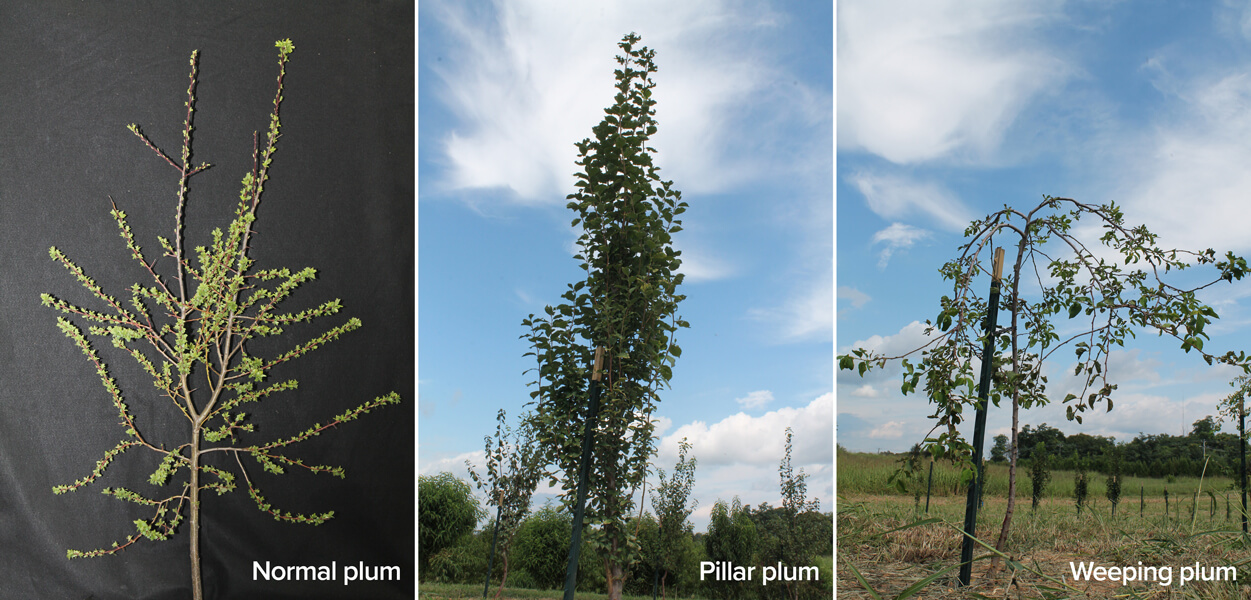
The familiar shape of a regular plum tree (left) is transformed by dialing down the activity of certain plant architecture genes, leading to plums with erect branches that shoot straight up (middle) or plums with branches that cascade downward (right).
CREDIT: C. HOLLENDER (LEFT), C. DARDICK (CENTER AND RIGHT)
Work by breeders, biologists and botanists have revealed sizable pockets of knowledge about the hormones, genes and processes that yield the diverse shapes of trees and other plants, between species and within species. It has not been easy: Two of trees’ most appealing attributes — their long lives and large sizes — make them intractable research subjects.
But as scientists pursue these questions, commonalities are emerging between vastly different species. The puzzle of shape diversity and adaptability turns out to be tied to the fundamentals of being a plant: grappling with gravity, fighting for sunlight, all while anchored in one place for a lifetime.
“Plants are stuck. The best they can do is grow toward something,” says Courtney Hollender, a former postdoc of Dardick’s who now runs her own lab in the Department of Horticulture at Michigan State University in East Lansing. “That’s all they’ve got; they can’t run, they have to adapt to their environment. And they’ve developed brilliant ways to do it.”
Available at all branches
Scientists have a word for the ability to adapt so readily: plasticity. In plants, this feature is both obvious and astounding. Most animals are born in specific shapes then just grow larger, but plants are modular — they grow in various iterations of two building blocks: shoots and roots.
It is the first of these — where and when a shoot grows or doesn’t grow — that governs the basic form a tree takes.
Some aspects are hardwired. Leaves emerge in a pattern that is usually fixed throughout the tree’s life, with structural arrangements that tend to be shared by members of a given plant family. And shoots emerge where leaves meet the stem. So, for example, plants in the maple family, which have leaves set opposite each other, have branches in the same format. Members of the beech family have leaves, and thus branches, that alternate up the stem.
But the interplay between physiology and external forces also plays a large part. Take your standard-issue plant with a main central stem that grows upward and has few side branches. Most plants, from basil to birch, start out this way, a growth habit that probably evolved because it enables them to quickly reach the light — more rapidly than the competition. Called apical dominance (the tip of the plant is the “apex”), this is largely under the purview of the plant hormone indole acetic acid, also known as auxin. Made in the tip, auxin diffuses downward and blocks the growth of side branches.
This is why pinching the tips off of basil or geranium makes them bushy — you are removing the source of that bossy auxin, freeing buds on the stem’s sides from the prohibition and allowing them to grow. (Though auxin is mighty, it’s not the only player here. Other plant hormones, along with light intensity and access to nutrients, also wield power.)
Another related and less-understood phenomenon occurs in some tree species. Called apical control, it also is imposed by the tip of a tree and probably also by auxin. But rather than operating at the scale of a branch, it commandeers the whole dang tree.
Think of a pine. At the top, there’s a pointy tip, then upper branches that tend to reach skyward. Moving down, the branches become more horizontal, growing out more than up. But unlike a basil plant, a pine tree does not become bushy when you lop off the top. Instead, a new bud near the top grows upward, becoming the new leader. Or an existing branch reorients to grow up and become the new dominant tip.
These two principles are always in the back of arborists’ minds as they work. “They have to consider, ‘If we cut a branch here, that bud below is going to break and we’ll just get a branch in basically the same spot,’” Dardick says. “All of their rules of what to prune and where are based on these physiological factors that contribute to tree shape.”
A natural reaction
Physiology also underpins the plastic responses trees have to more extreme situations they may face. A tree on a high mountain peak or windswept coast must contend with exposure to mechanical forces that could topple and kill it. To survive, such trees become short and stocky, their bent, asymmetric crowns reducing drag and presumably protecting a tree from violent gusts. The driver is the wind’s very touch — a response now called thigmomorphogenesis that has been observed for hundreds of years.
How it works is still unclear, but over the past decade researchers have made some headway. They’re actively studying force-sensing proteins and processes that may be involved. And recent work suggests an important role for hormones such as jasmonate, which accumulates in all kinds of plants in response to damage and mechanical stress. In experiments with a weedy mustard called Arabidopsis, plants became stunted when researchers bent their leaves back and forth twice a day. Mutants that couldn’t make jasmonate, though, grew normally.
Sometimes, wind does more than gust against a tree: It blows the whole tree over, and that tree, if still rooted, must reorient the growth of its branches and buds toward the sky. Avalanches, erosion and landslides deal similar fates. And trees in all sorts of circumstances must grow around obstacles, away from competitors and toward the light. To get these jobs done, trees make a special kind of wood called reaction wood.
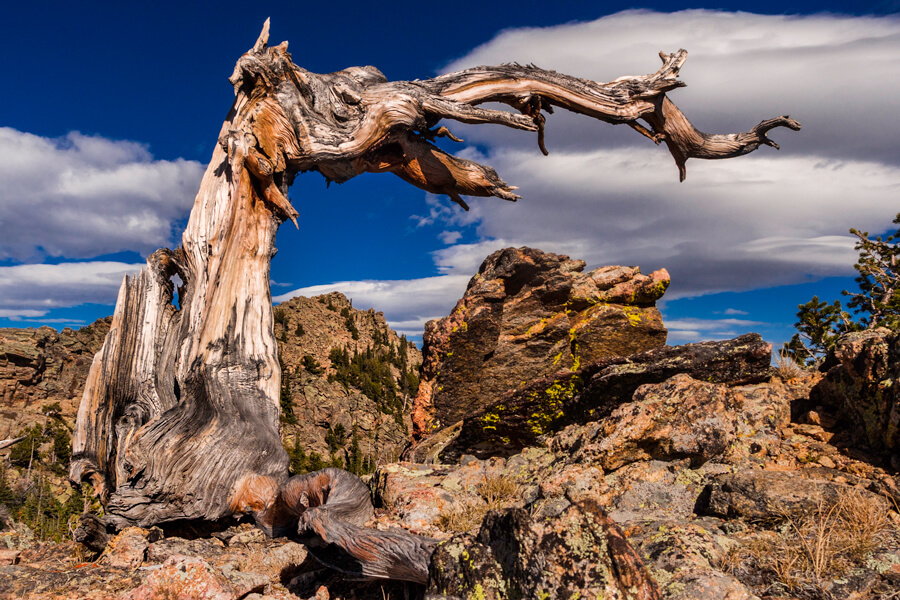
Trees may become contorted in challenging physical environments, such as this ridge in the Rocky Mountains. The touch of wind and other forces prompt physiological responses by the plant that yield a shorter, stockier stature, gnarled asymmetric shape and the development of specialized wood. This characteristic tree form is called a krummholz (German for “crooked wood”).
CREDIT: BRYCE BRADFORD / FLICKR
Hardwoods such as maple, beech, oak and poplar form this tough stuff (in this case called tension wood) on the upper side of their stems. Incredibly, it creates a tensile force that pulls the stem upward. “If you walk around the woods, you can see that most species, if not all species, have this kind of reaction wood response,” says Andrew Groover, a research geneticist with the USDA Forest Service’s Pacific Southwest Research Station in Davis, California.
The hardwood tree first discerns that it is off-kilter using specialized gravity-sensing cells. Where these cells reside in trees — the woody stem? the tip of new shoots? — was unknown until Groover and colleagues detected them in woody and soft tissues of poplar, a few years back. The cells contain organelles called statoliths that sink down in the cell and indicate to the plant that it’s leaning one way or the other. This, in turn, causes that influential auxin to mobilize, triggering the growth of tension wood on the top. Cellulose with a peculiar gelatinous layer is thought to act as the “muscle” that generates the pulling-up force.
In this experiment, young, potted poplar trees were placed sideways to investigate the plants’ gravity-sensing machinery. The poplar in this time-lapse movie, taken over two weeks, responded to being tipped on its side by reorienting its growth upward. The plant hormone auxin is key to this response. Mutants that cannot respond appropriately to auxin’s signaling instructions do not right themselves this way. (This particular poplar also received a dose of a chemical called gibberellic acid that interacts with auxin, so that scientists could learn more about its role.)
CREDIT: ANDREW GROOVER AND SUZANNE GERTTULA, US FOREST SERVICE, PACIFIC SOUTHWEST RESEARCH STATION DAVIS CA
When genes defy gravity
Much of the knowledge about the architecture of plants is rooted in millennia of human efforts to alter crop shapes to make them more suitable for cultivation, and modern science is now revealing the genetic changes that lie behind these creations. The lessons, it turns out, apply broadly across the plant kingdom, to herbaceous and woody species alike.
It is hard to overstate the importance to human history of some of these plant-shape changes, says plant molecular geneticist Jiayang Li, who details some of their genetic underpinnings in the Annual Review of Plant Biology. A classic example is the transformation of the ancestor of corn (maize) into a key staple crop for much of the world. It arose from a species of the Central American grasses called teosintes — bushy plants with many branches. Domestication, among other things, abolished that branching, yielding the single-stalked upright corn we plant today.
Similarly, explains Li, who works at the Chinese Academy of Sciences’ Institute of Genetics and Developmental Biology, the green revolution of the 20th century ushered in compact, dwarf varieties of wheat and rice. By modifying the height and thickness of the stems of these grasses, breeders developed varieties that could carry more grain without toppling over in wind and rain.
Much of Li’s own research has focused on architectural variation in rice, although the work turns out to have implications for the architecture of plants in general, from lowly mosses to towering trees. Like other grasses, rice grows shoots called tillers — specialized, grain-bearing branches that emerge from the base. In cultivated rice, the angle at which these tillers grow varies widely: Some varieties are squat and wide-spreading, others have shoots that are more upright. Breeders are interested in altering tiller angle because upright plants can be grown more densely, giving farmers more bang for their acreage.
In a key advance, in 2007, a team including Li reported they’d discovered the genetic cause of the spread-out architecture trait. The scientists named the responsible gene TAC1, short for “tiller angle control.” A functional TAC1 gene increases rice’s tiller angle, leading to open, widely branching plants. Mutations in TAC1 lead to the opposite: plants with erect shoots that reach up, instead of out.
That same year, Li’s team and a group in Japan both reported another major achievement: finding a long-sought gene behind a curious trait in some rice varieties that gives plant branches a scruffy, lounging look. The trait, known as “lazy,” had intrigued plant breeders and geneticists since the 1930s, when researchers described its extreme manifestation in corn: “The lazy plants grow along the ground, following the unevenness of the surface.”
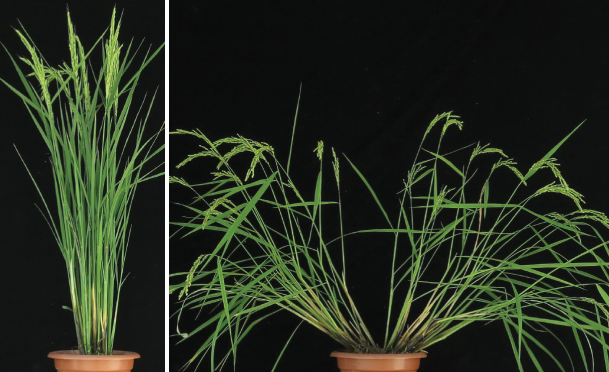
In ordinary rice (left), the hormone auxin helps to tell the plant which direction is up. Auxin transport within the plant goes awry when a gene called LAZY malfunctions, leading to confused plants with sprawling branches (right).
CREDIT: B. WANG ET AL / AR PLANT BIOLOGY 2018
The cause, it turns out, was errors in a gene that normally makes branches shoot straight up. Li and his colleagues surveyed some 30,000 mutant rice plants to pin down that gene, now called LAZY (names of genes, confusingly, often refer to what happens when a gene is mutated and doesn’t work, rather than when it is functioning properly). And they provided convincing evidence for an idea batted around for decades — that lazy plants have muddled perceptions of gravity and that auxin is centrally involved.
A common test for whether a plant’s gravity-perception machinery is working is to lay the plant on its side. If it knows up from down, it won’t continue to grow sideways, but will start to grow up again, akin to the reaction-wood response of a toppled tree’s branches. An important step in this reorienting involves auxin pooling on the bottom side of the shoot. But in lazy mutants, proteins that help ferry auxin around the plant are malfunctioning, so instead of shoots growing in the correct direction, they’re prone to casually sprawl about.
Scientists now know that LAZY genes come in multiple versions. Some appear to operate in plant roots, telling them which way is down, probably using similar, auxin-related signals. If those genes are absent or inactive, confused roots grow upward. And though the genes were first found in monocots, a branch of the plant kingdom including rice and corn, researchers now know that LAZY genes exist in numerous plants, including the plums growing in the fruit research station in West Virginia.
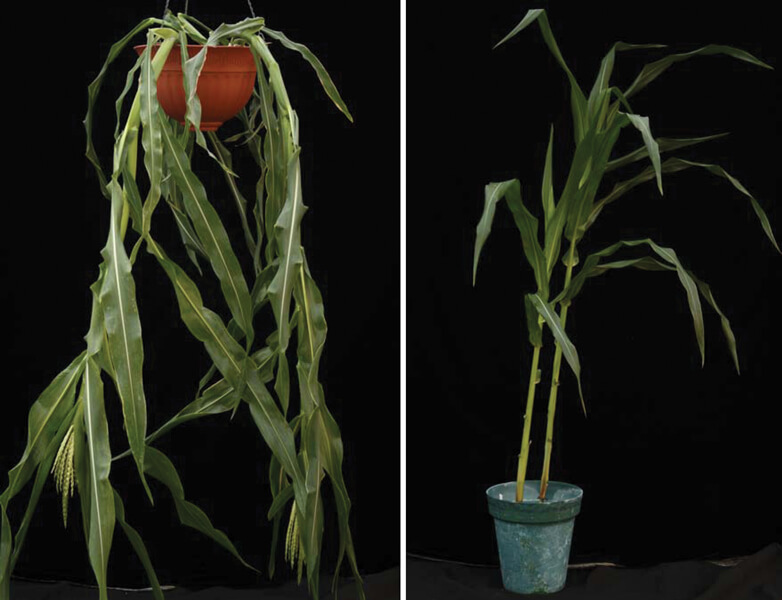
A lazy mutant of corn (left) compared with normal corn (right). Such corn mutants were described nearly 100 years ago, but it took 21st century molecular biology to nail down the growth habit’s cause: genetic malfunctions that meddle with responses to gravity.
CREDIT: T.P. HOWARD III ET AL / PLOS ONE 2014
Reaching upward and outwards
As our boots crunch along the uneven ground, Dardick points at an errant orchard cat watching our tree tour from a distance. One row of trees stands so upright that a fencepost at the end of it is enough to block the row from view. These regimented trees are “pillar” peaches, and they are favorites of landscapers (one reason: it’s easy to get around them with a lawnmower). They also were key to uncovering genes like LAZY and TAC1 at the Shenandoah Valley station.
By comparing ordinary peaches to pillar peaches, and drawing on decades of work by former lead scientist Ralph Scorza, a team of station scientists and others in the US and Germany discovered the cause of the pillar trait: mutations in the peach version of TAC1.
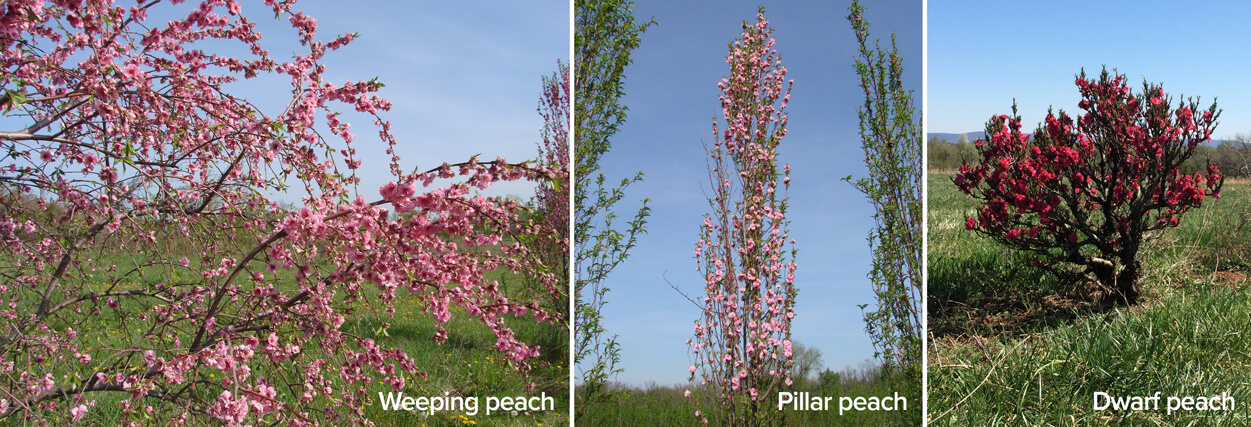
Many of the strange plant architectures under investigation existed as naturally occurring varieties that were developed by breeders for ornamental gardens or orchards; only recently have the genes underlying these forms been identified. It’s now known that the upright growth habit of the pillar peach (center), available commercially under the name “Crimson Rocket,” results from mutations in a gene that helps plants branch outward.
CREDIT: C. DARDICK
The team also found that LAZY was at work in many of their misfits. Just as with the corn plants described nearly 100 years ago, mutations in LAZY made plums grow topsy-turvy, their branches seeking the soil. Apple trees with LAZY mutations have similarly disoriented roots. And when multiple copies of LAZY genes malfunction in the weed Arabidopsis, its roots grow up, its shoots down.
In the last decade, researchers have found that TAC1 influences branch angle in plums, poplar trees, the grass Miscanthus and Arabidopsis, and it appears to affect leaf angle in corn. But LAZY genes have even deeper roots. They’re found in all manner of plants, including the evolutionarily older Loblolly pine and even more ancient mosses.
This finding suggests a very old role for LAZY: It may have allowed plants to grow up, literally, when they first colonized land. Plants got their start in water. There, rootless and leafless, they were buoyed, unconcerned with gravity. The transition to land spurred the development of proper roots and stems, and plants then had to figure out up from down. LAZY seems to have allowed plants to orient their above-ground growth away from gravity and up toward the sun.
Scientists think that TAC1 evolved somewhat later, providing a counterpoint to LAZY — ensuring that branches don’t only grow straight up, but also reach out. Together, these genes laid critical groundwork for the diversity of plant forms we see today, all seeking sustenance in their own ways.
“Once you start to grow up as a vascular plant, you need to maximize your resources, you need to capture as much sun as possible,” says Hollender, who has been working on yet another gene, called WEEP, that — when nonfunctional — lends plants a weeping, waterfall-like structure seen here and there in trees of ornamental gardens. (But it’s probably not responsible for the shape of weeping willow trees.) “Modifying your shoot angles is an important adaptive trait for plants that allows them to capture light. It’s essential for them to survive.”
This kind of research has broad economic implications. Fruit and nut trees bring $25 billion annually in the US alone and there are hefty costs associated with pruning, bending and tying branches; spraying hormones; and the manual labor of picking fruit from an unruly cacophony of limbs. Understanding the genetic controls behind tree architecture could help scientists breed trees that make the whole fruit-farming enterprise more efficient and environmentally friendly.
“Orchard systems are not the most sustainable in the world,” Dardick says. “The idea is, if we can modify tree architecture, if we could reduce their size and limit the amount of area they take up, then we could plant them at higher density and potentially increase their sustainability.”
And there may be odder outcomes than friendlier outdoor orchards: In collaboration with NASA, the USDA team is investigating genetic tweaks that might even help bring fruit to space. On that December day, Dardick takes me to a greenhouse tucked in a corner of the lab. In it are plum and apple trees whose shape is so transformed that they look more like the love children of shrubs and vines. This strange growth habit is a side-effect of efforts to breed plants that flower and make fruit sooner and then do so continuously, rather than flowering after growing for several years, and then only in the spring.
The genetic tweaks that sent the trees’ developmental program into overdrive have also transformed their architecture. In the greenhouse, these precocious “trees” sprawl, draping lazily along wire trellises, happily flowering and heavy with fruit. “They’re growing almost like tomatoes,” Dardick says. “So we’re broaching the concept of, can we bring an orchard indoors?”
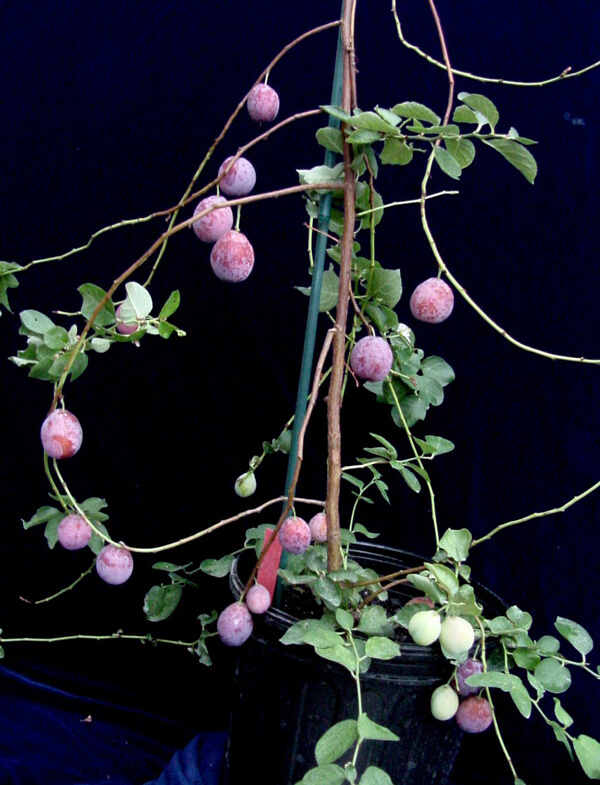
The strange, vine-like growth of this plum results when a gene controlling the timing of flower development malfunctions. Such unusually shaped “trees” may facilitate indoor “orchards” that produce fruit many months of the year.
CREDIT: C. SRINIVASAN
Those ambitions aside, Dardick has his hands full trying to answer numerous basic-science questions about how trees do what they do. Researchers still don’t know how different tree species set the angles of their branches — going wide like an oak, or arching like an elm. They don’t know how trees alter those angles during the course of mature growth, as branches sprout from branches sprouted from branches, until some of them finally point down. Trees are both kindred and foreign to us, their various forms so familiar, but their architectural rules still in so many ways opaque.
“I find myself looking at trees all the time now in a new way; they fill space so beautifully and efficiently,” Dardick says. “They are the biggest organism we have that’s visible, that’s in our face all the time. But there’s so much we don’t know.”




